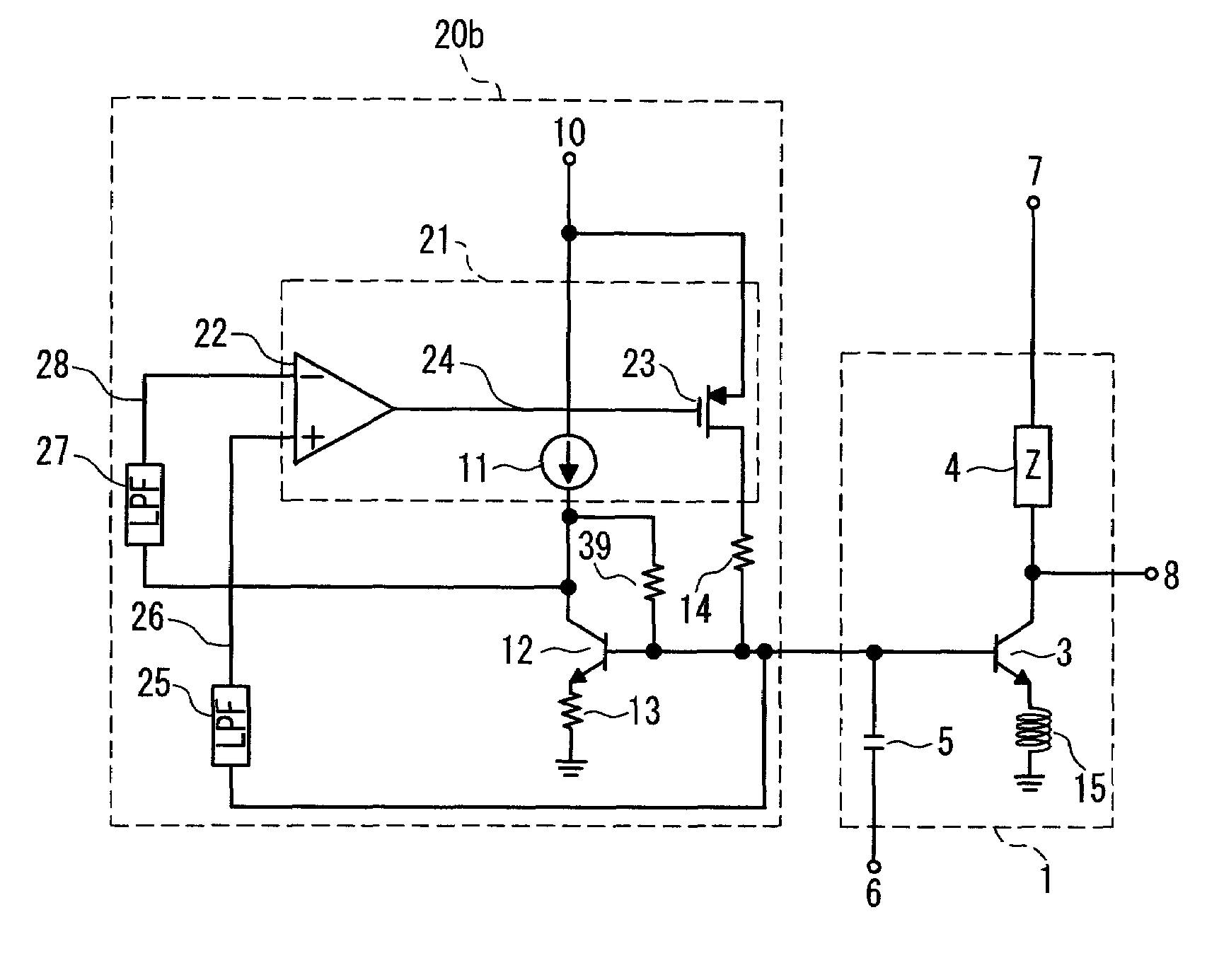Power amplifier
a power amplifier and amplifier technology, applied in the direction of amplifiers, amplifiers with semiconductor devices only, amplifiers with semiconductor devices, etc., to achieve the effect of less power and smaller chip area
- Summary
- Abstract
- Description
- Claims
- Application Information
AI Technical Summary
Benefits of technology
Problems solved by technology
Method used
Image
Examples
embodiment 1
[0033]FIG. 2 is a circuit diagram showing a power amplifier according to a first embodiment of the present invention. This power amplifier includes the RF operation section 1 and a DC bias circuit 20a. Similarly to the RF operation section 1 in the conventional example shown in FIG. 1, the RF operation section 1 includes the RF operation transistor 3, the impedance 4, the DC blocking capacitor 5, and the feedback inductor 15. Accordingly, redundant description will be omitted.
[0034]The DC bias circuit 20a has a configuration in which the base current compensation transistor 9 in the DC bias circuit 2 shown in FIG. 1 is replaced by a base current compensation circuit 21. Therefore, the same reference numerals will be assigned to the identical elements, and redundant description will be omitted. The base current compensation circuit 21 includes an operational amplifier 22 formed of CMOS and a voltage-to-current conversion transistor 23. An output 24 of the operational amplifier 22 is ...
embodiment 2
[0048]FIG. 6 is a circuit diagram showing a power amplifier according to a second embodiment of the present invention. In FIG. 6, the same reference numerals will be assigned to like elements in the circuit according to the first embodiment shown in FIG. 2, and redundant description will be omitted.
[0049]In this embodiment, a DC bias circuit 20b has a configuration in which a starting resistor 39 is inserted between the collector and the base of the current reference transistor 12 in the circuit according to the first embodiment. Hereinafter, an operation of this power amplifier will be described.
[0050]In a case where the starting resistor 39 is not provided, the base potential of the current reference transistor 12 is substantially 0 V when the power source is turned on. Therefore, it will take more time for equalizing the collector potential and the base potential of the current reference transistor 12 based on a feedback from the operational amplifier 22. On the contrary, the dif...
embodiment 3
[0053]FIG. 7 is a circuit diagram showing a power amplifier according to a third embodiment of the present invention. In FIG. 7, the same reference numerals will be assigned to like elements in the circuit according to the first embodiment shown in FIG. 2, and redundant description will be omitted.
[0054]In this embodiment, a DC bias circuit 20c has a configuration in which a phase adjusting section 40 is inserted between the first input 26 of the operational amplifier 22 and the base of the current reference transistor 12 in the circuit according to the first embodiment, and a phase adjusting section 41 is inserted between the second input 28 of the operational amplifier 22 and the collector of the current reference transistor 12. It is not necessarily required to provide the phase adjusting sections 40, 41 to both the first input 26 and the second input 28, and the phase adjusting section may be inserted into either one of the inputs. Hereinafter, an operation of this power amplifi...
PUM
 Login to View More
Login to View More Abstract
Description
Claims
Application Information
 Login to View More
Login to View More - R&D
- Intellectual Property
- Life Sciences
- Materials
- Tech Scout
- Unparalleled Data Quality
- Higher Quality Content
- 60% Fewer Hallucinations
Browse by: Latest US Patents, China's latest patents, Technical Efficacy Thesaurus, Application Domain, Technology Topic, Popular Technical Reports.
© 2025 PatSnap. All rights reserved.Legal|Privacy policy|Modern Slavery Act Transparency Statement|Sitemap|About US| Contact US: help@patsnap.com



